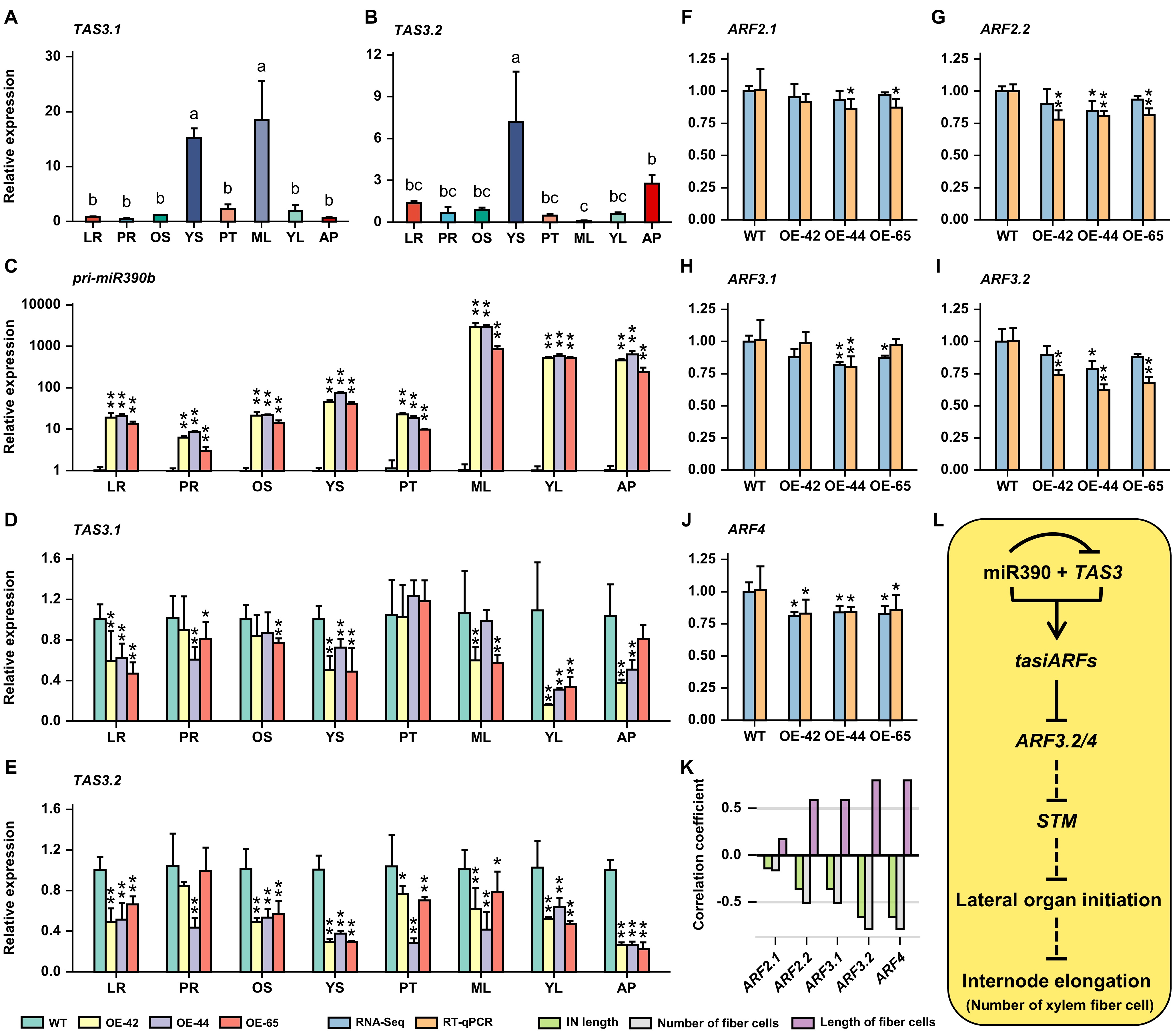
图1 miR390b过表达促进杨树茎伸长

图2 miR390-TAS3-ARFs途径基因表达水平及ARF和生长数据相关性分析
南湖新闻网讯(通讯员 施雪萍)近日,我校园艺林学学院植物维管生物学课题组在Horticulture Research上线了(Advance Access)题为“Overexpression of miR390b promotes stem elongation and height growth in Populus”的研究论文。这项工作发现miR390b可通过miR390-TAS3-ARFs模块调控杨树茎伸长和高生长,该研究为揭示树木高生长的调控机制提供了重要参考,也为树木遗传改良与丰产速生提供了理论依据。
杨树(Populus)是在世界范围内广泛种植的速生用材树种,也是城市绿化和生态建设中常见的优良树种,具有重要的经济价值和生态价值。然而,传统的杨树品种选育主要依靠杂交育种和多倍体育种,育种周期较长,严重制约了杨树新品种的创制。随着杨树遗传转化技术的不断完善以及杨属多个树种全基因组测序的完成,通过基因工程技术定向培育优质高产的杨树新品种,是加快我国林木良种化进程,解决木材需求,推动现代林业产业发展的重要手段和有效方法。
该研究以杨树为材料,通过茎初生生长、次生生长转变和次生生长等不同发育阶段的小RNA测序分析,挖掘到多个可能参与调控杨树茎发育的microRNA候选基因,其中miR390在初生生长过程中具有较高表达。通过miR390b在杨树中的遗传转化发现,过表达miR390b使杨树茎节间长度、木质部纵向的纤维细胞数目和株高均显著增加;基因表达分析和烟草瞬时转化实验表明,TAS3.1与TAS3.2为miR390的靶基因,可被miR390直接剪切;miR390-TAS3通路下游基因ARF2.2、ARF3.2和ARF4均在miR390b过表达植株的茎尖组织中表达量下调,其中ARF3.2和ARF4表达量与过表达植株的木纤维细胞长度呈正相关,与木纤维细胞数量和节间长度呈负相关。该研究结果揭示了miR390b通过miR390-TAS3-ARFs模块调控杨树茎伸长和高生长,这在其它植物中鲜有报道。
我校园艺林学学院植物维管生物学课题组已毕业博士生史巧芳为第一作者,施雪萍副教授为通讯作者。园艺林学学院郑波教授、郭文武教授、伍小萌副教授和已毕业博士生田冬冬参与了研究工作,李峰教授和杜克兵副教授分别为本研究馈赠了pMS4v2质粒和黑杨材料。本研究得到了国家自然科学基金、神农架林区林业科学研究院科技计划项目、中央高校基本科研业务费专项资金资助项目的资助。
【英文摘要】
MicroRNA390 (miR390) is involved in plant growth and development by down-regulating the expression of the downstream genes trans-acting short interfering RNA3 (TAS3) and AUXIN RESPONSE FACTORs (ARFs). There is a scarcity of research on the involvement of the miR390-TAS3-ARFs pathway in the stem development of Populus. Here, differentially expressed miRNAs during poplar stem development were screened by small RNA sequencing analysis, and a novel function of miR390b in stem development was revealed. Overexpression of miR390b (OE-miR390b) resulted in a large increase in the number of xylem fiber cells and a slight decrease in the cell length at the longitudinal axis. Overall increases in stem elongation and plant height were observed in the OE-miR390b plants. According to transcriptome sequencing results and transient co-expression analysis, TAS3.1 and TAS3.2 were identified as the target genes of miR390 in poplar and were negatively regulated by miR390 in the apex. The transcription levels of ARF3.2 and ARF4 were significantly repressed in OE-miR390b plants and strongly negatively correlated with the number of xylem fiber cells along the longitudinal axis. These findings indicate that the conserved miR390-TAS3-ARFs pathway in poplar is involved in stem elongation and plant height growth.
原文链接:
审核人 郑波
